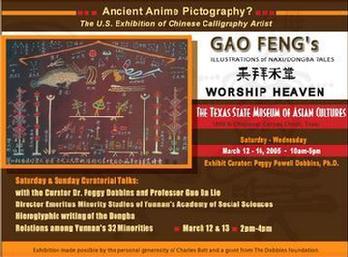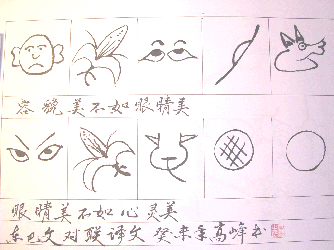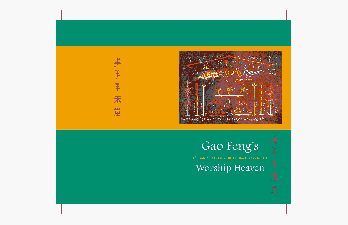In the catalog published by the Texas State Museum of Asian Cultures, Professor Guo wrote:
In Dongba pictography, a pictorial sign does not exactly belong to one particular sound; nor does a sign belong exactly to one particular meaning. Thus even though a scholar may recognize all the single words in a text, they may not understand the whole, -- unless they knew the whole story already -- as the Dongba shamen do.
It was what the Naxi born and bred, anthropology trained Guo went on to say in the next paragraph that I imagine invited Gao to engage as profoundly and creatively as he has without being a Dongba shamen or even a native member of Naxi culture:
As Naxi is a living culture and Dongba a pictographic writing still in use, it continues to develop, not in isolation, but in conscious creative interaction with artistgs and scholars who reveal new mysteries viewed through the lens of the different experiences and backgrounds they bring.
Our
Naxi origin tale for American children is not so pretentious as Pound's
100 years ago. But we believe it makes a point that it is about time
to make.
|
 |
| click invitation to U.S. Exhibition of Gao Feng's Drawings and Narrative of the Naxi/Dongba tale "Worship Heaven" at the Texas State Museum of Asian Cultures, March, 2005, for the Corpus Christi Festival of Arts |
|
|
 |
| click above for some famous Gao Feng drawings using Dongba symbols |
|
|
 |
| click to pages of exhibit catalog published as illustrated children's tale of Naxi Genesis |
|
|
By
the time the Naxi myth Worship Heaven was read to an American child, the tale had passed orally from anonymous ancient to ancient Naxi; then orally to Naxi shamen, the Dongbas, who depicted the story of the Naxi origin on paper; this story in pictoral writing was transcribed and retold from Dongba to Dongba; finally it was transliterated and
interpreted from Naxi to Chinese in Professor Fang Guo Yu's Book of
Naxi Pictography; Gao Feng studied Professor Fang Guo Yu's Naxi pictographs and interpretations, and represented the Naxi/Dongba pictographic store with a text in Chinese for Chinese students to enjoy. Hu Ying translated Gao
Feng's text to English, and I poeticized it.
|
|
|